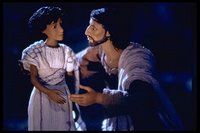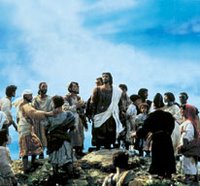 For those not in the know, I'll give a brief overview. The film was the product of a Russian / Welsh collaboration, by the same company who made the Testament: Bible in Animation series of 30 minute films based on stories from the Hebrew Bible. So this was the first (and still the only) feature length animated Jesus film. The majority of the film is shot using "claymation" (animation using plasticine / modelling clay as used by films such as Wallace and Gromit: The Curse of the WereRabbit). This style seems to be more popular in Britain than in America.
For those not in the know, I'll give a brief overview. The film was the product of a Russian / Welsh collaboration, by the same company who made the Testament: Bible in Animation series of 30 minute films based on stories from the Hebrew Bible. So this was the first (and still the only) feature length animated Jesus film. The majority of the film is shot using "claymation" (animation using plasticine / modelling clay as used by films such as Wallace and Gromit: The Curse of the WereRabbit). This style seems to be more popular in Britain than in America.I've enjoyed this film many times before. It was actually only the second ever Jesus film I had seen in the cinema (the first was Jesus (1979) years ago). What is remarkable about it is that despite being filmed using plasticine figures, it catches the humanity of Jesus more than any other film. At the same time it also does a good job of catching his divinity. Viewers familiar with a number of Jesus films will know that this is one of the issues that always come up when Jesus films are discussed. The earlier films emphasised his divinity by making him seem s remote and detached. By the time King of Kings came along in 1961, film-makers were beginning to talk about putting more emphasis on his humanity, but seemed unable to free him of this remoteness. Conversely more recent films have continued in the quest to portray a more human Jesus, but seemed to have sailed straight past the target. Last Temptation of Christ portrayed a man wracked by various emotional disorders - as, I think, Lloyd Baugh pointed out, it is not the film's low view of divinity that is the problem, but it's low view of humanity. Other recent films such as the Jesus mini-series that was also released in 1999, and 1996's The Visual Bible Matthew are trying so hard to portray him as someone who liked to laugh that he ends up too much of a clown, and lacking any sense of substance.
 Somehow The Miracle Maker seems to get this just right. Jesus is incredibly good with people, he uses gentle humour in his teaching, and knows how to smile, but never compromised the sense that this is someone significant. Perhaps it's Ralph Fiennes's voice that does the work, or the fact that not using an actor makes it easier. Either way it's an incredible achievement, and one that has moved me to tears in the past. Strangely, I was never that moved by The Passion of the Christ.
Somehow The Miracle Maker seems to get this just right. Jesus is incredibly good with people, he uses gentle humour in his teaching, and knows how to smile, but never compromised the sense that this is someone significant. Perhaps it's Ralph Fiennes's voice that does the work, or the fact that not using an actor makes it easier. Either way it's an incredible achievement, and one that has moved me to tears in the past. Strangely, I was never that moved by The Passion of the Christ.There are other things I have always loved about this film. The use of animation is excellent. For those who have not seen it, whilst most of the film is claymation, there are several scenes shown using 2D hand drawn animation. These scenes are the ones that are either flashbacks (such as the nativity episodes), or more supernatural (such as the deliverance of Mary Magdalene), or for Jesus's parables and teaching. There are numerous results of this. One is that it helps keep younger viewers engaged. Perhaps most significantly though, is that it allows the film to be more emotional and expressionistic at these more imagery-rich moments of the story.
 That said, this time round there were a few things I really only noticed for the first time. Perhaps most significantly I was struck by how historically rooted this version of the Jesus story was. I kept thinking Tom Wright would like that, and thus wasn't surprised when both he, and the now Archbishop of Canterbury Rowan Williams were both named as advisors at the end of the film. For example, there is a scene between Pilate and the centurion long before the crucifixion where they discuss the revolt the centurion has just put down by crucifying 117 rebels. Whilst I believe the timing of this incident is not based on a specific historical incident, it does emphasise what most Jesus films miss - that Jesus's execution was, from a Roman point of view, nothing out of the ordinary.
That said, this time round there were a few things I really only noticed for the first time. Perhaps most significantly I was struck by how historically rooted this version of the Jesus story was. I kept thinking Tom Wright would like that, and thus wasn't surprised when both he, and the now Archbishop of Canterbury Rowan Williams were both named as advisors at the end of the film. For example, there is a scene between Pilate and the centurion long before the crucifixion where they discuss the revolt the centurion has just put down by crucifying 117 rebels. Whilst I believe the timing of this incident is not based on a specific historical incident, it does emphasise what most Jesus films miss - that Jesus's execution was, from a Roman point of view, nothing out of the ordinary.Later on there we are shown the post-resurrection appearance to Cleopas and companion on the Road to Emmaus. Whilst the exact quote escapes me, there is also some discussion here of what resurrection actually meant in that period.
 Which brings me on to another thing I like about the film - the attention given to the resurrection. This is probably the section of the gospels filmed with the most variation and creativity of all. Whilst some films have excluded it all together, such as Son of Man (1969), others have taken more creative, but ambiguous, interpretations (Jesus of Montreal, Jesus Christ Superstar, Last Temptation of Christ). Of those that have chosen to show a more literal interpretation, they have either given it relatively short shrift (Jesus of Nazareth) or eschewed the biblical accounts and replaced them with their own interpretations of what happened (The Passion of the Christ).
Which brings me on to another thing I like about the film - the attention given to the resurrection. This is probably the section of the gospels filmed with the most variation and creativity of all. Whilst some films have excluded it all together, such as Son of Man (1969), others have taken more creative, but ambiguous, interpretations (Jesus of Montreal, Jesus Christ Superstar, Last Temptation of Christ). Of those that have chosen to show a more literal interpretation, they have either given it relatively short shrift (Jesus of Nazareth) or eschewed the biblical accounts and replaced them with their own interpretations of what happened (The Passion of the Christ).In contrast, The Miracle Maker shows Mary finding the empty tomb (John 20:1)and then meeting the risen Jesus (John 20:11-18), Mary telling Peter, and him running to the tomb (John 20:2-7), Peter meeting Jesus (a fictionalised abbreviation of John 21:15-19), The Road to Emmaus (Luke 24:13-35), And the second appearance to the disciples, including Thomas (John 20:36-41), and the Ascension (Luke 24:48-53).
I'll post a full scene guide in a few days, but if you fancy watching a Jesus film at some point over the Easter period, and you haven't seen this one yet, then I'd strongly recommend it.
Edit [5:25pm]
I've just noticed that Lesa Bellevie over at The Magdalene Review has also just seen this film and posted her comments on it. Obviously she's mainly concerned with Mary Magdalene, so she analyses that part of the film in some depth. There are also some pictures from the deliverance scene. FWIW this is one of the few films that actually depicts Mary along biblical, rather than traditional lines (i.e. she is someone who Jesus casts seven spirits out of and who witnesses his resurrection, but she is NOT a prostitute)
I've also now written some notes on my Scene Guide.
Thanks for the comment and the link, Matt. I definitely agree with your summary of the film, especially on the divinity and humanity of Jesus and the use of 2D animation alongside the claymation. It made for a powerful combination, and even my three year old stayed tuned in longer than usual.
ReplyDeleteGreat comments, Matt -- makes me want to see it again, myself! I hadn't thought about the film's uniqueness in terms of its emphasis on the Resurrection, but you're probably right about that.
ReplyDeleteRe: the "traditional" understanding of Mary Magdalene as a prostitute, this is an exclusively Catholic-Protestant tradition, and not an Orthodox one. :)
Thanks Lesa - It's interesting to hear some anecdotal evidence to back up my hunch!
ReplyDeleteThe film also makes itself accessible to children by the emphasis on the story of Tamar (Jairus's daughter). Not only is this story gien more background, and significantly expanded on, but it's used as a device to view Jesus through. If I recall correctly, the first time we see Jesus, it is from her point of view. So there's a character that it's easy for children to identify with and look at Jesus through their eyes.
Matt
: Re: the "traditional" understanding of
ReplyDelete: Mary Magdalene as a prostitute, this is
: an exclusively Catholic-Protestant
: tradition, and not an Orthodox one. :)
Ha, yes, I wondered if you might bring that one up :)
Matt
Hi~ Matt
ReplyDeleteI want to know how to donate some money for those which make films like "Miracle Maker", "Joseph-King of Dreams" and so on. If you know the way to support them, let me know. I just feel terrible that these kind of films were spread as free download..
My email address is kylesparrow52@gmail.com.
Please contact me by email. It is convenience for me to notice your response.
Best Regards
Kyle